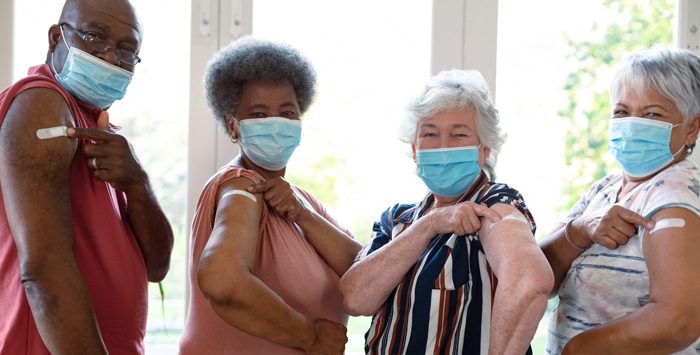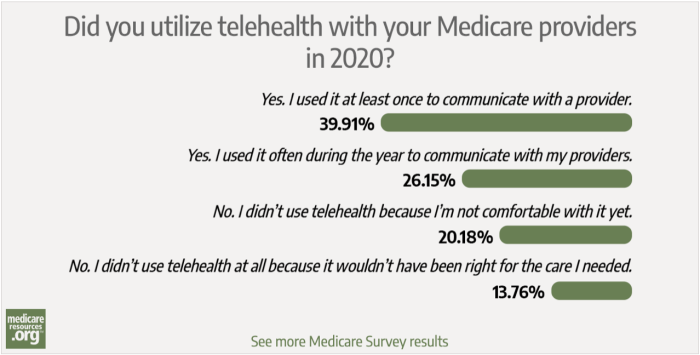Access to care is important not only for emergencies but for management of chronic health conditions. Telehealth, also known as telemedicine, increased that access for millions of individuals during the COVID-19 pandemic that began in early 2020.
After the government declared COVID-19 a national public health emergency, telehealth took off. The number of telehealth visits increased by more than 4,300% in March 2020 when compared to 2019. A survey by the RAND Corporation found that 2052 out of 2622 (78%) people with commercial insurance – including Medicare Advantage – used telehealth between March and May 2020. Commercial insurance refers to health plans that are run by private insurance companies, not by the state or federal government.
Former CMS director Seema Verma reported, in an article for Health Affairs, that more than 9 million Medicare beneficiaries used telehealth services during that time with a third of them simply doing so by phone.
Is telehealth here to stay?
Defining telehealth
Tele- is derived from Greek, meaning “at a distance”. Think about how long we have used tele-technology. The telephone was invented in 1876. This was followed by the first radio broadcast in 1900 and the first television broadcast in 1927.
Telehealth is defined as healthcare “at a distance.” Medicare traditionally will cover care by certain healthcare providers if those services are given by two-way communication that uses both audio and video technology. You also had to be in certain locations, such as a doctor’s office or a hospital in a rural area. If you needed dialysis, regardless of where you were located, there was also a Medicare option for telehealth coverage.
Passage of the Coronavirus Aid, Relief, and Economic Security Act (CARES Act) in March 2020 changed the requirements for telehealth coverage, at least during the public health emergency, which ended on May 11, 2023. CARES increased Medicare coverage for more types of telehealth services regardless of where you were located in the country. Many of these services would continue through December 31, 2024 (subsequently extended to March 31, 2025 by legislation that was enacted in December 2024).
During this time, it was no longer necessary to use technology that used both audio and visual for all telehealth services. Healthcare providers could deliver some types of care by audio-only telehealth too.
Limitations of video conferencing
The video requirement for Medicare coverage for telehealth appears to be the rate-limiting step. Not all Medicare beneficiaries have access to video conferencing technology and many may have physical limitations that decrease their ability to use it effectively, even when they do.
Take broadband connectivity. A high-speed, high-quality internet connection is a practical necessity for effective teleconferencing. Approximately 15% of Medicare beneficiaries live in rural communities. According to the Federal Communications Commission (FCC), approximately one in four people living in these communities do not have access to a broadband internet connection. Even when broadband services are available in rural communities, millions of Americans do not sign up for service whether for cost or other reasons.
Chronic medical conditions and disabilities can also take their toll on telehealth usage. According to the most recent National Health Survey, 13.1 million adults 65 and over have vision loss.
When you consider that 25.7 million American adults report severe arthritis pain that affects their day to day function, it’s possible dexterity issues could also come into play when it comes to using video conferencing equipment.
Easy access with audio-only services
It turns out the technology we needed all along was right in front of us. Telephones are easy to use and most people have access to one. Data from the National Health Statistics shows that more than 98.7% of Americans have access to a phone.
People who were unable to utilize video conferencing services, regardless of the reason, were able to access care with audio-only services if they needed to. The proof is in the pudding, as they say, with 3 million Medicare beneficiaries turning to their phones for telehealth visits in the first three months of the pandemic. This was a time when they did not have an option to go to the doctor’s office. It is possible they would have otherwise gone without needed care during this time.
Physician shortages are another factor to consider. Rural counties account for the majority of designated health professional shortage areas in the country. People may have to travel long distances to see a provider, if they can access one at all. As noted previously, individuals in these areas may have more limited access to teleconferencing because broadband access is less available. Limiting telehealth to audio-video conferencing, instead of just audio-only, can unfairly deprive care to people who are already at a disadvantage.
Legislative changes could be on the way
The pandemic showed us that audio-only telehealth can be beneficial for Medicare beneficiaries, especially for those living in rural areas. The question is whether audio-only services offered during the pandemic will continue to be offered after Dec. 31, 2024, when they are currently set to expire.
As it currently stands, audio-only telehealth is available to Medicare beneficiaries for a limited number of conditions. This includes services for behavioral and mental health, chronic kidney disease, diabetes, in-hospital care, medical nutrition, and speech therapy. After December 31, 2024, permanent audio-only telehealth coverage will continue for many mental health services.
A number of U.S. Representatives have sought to extend coverage for audio-only telehealth for the long haul. The Permanency for Audio-Only Telehealth Act, Preserving Telehealth, Hospital, and Ambulances Act, and Telehealth Modernization Act of 2024 are all proposals made to extend telehealth options for Medicare beneficiaries and lift pre-pandemic restrictions.
Previously, beneficiaries on Original Medicare had to be at a community mental health center, critical access hospital, doctor’s office, federally qualified health center, hospital, hospital- or critical access hospital-based dialysis facility, rural health clinic, or skilled nursing facility for their visit to be covered. They could not be at home. The one exception was people who required routine check-ups for home dialysis. The catch was that they had to have already received three months of in-person visits before telehealth visits would be covered.
Without Congressional action, these rules will return in 2025, preventing Original Medicare beneficiaries from accessing telehealth from their homes for most services. And in-clinic telehealth care for beneficiaries in non-rural areas will be limited to a fairly short list of services.
Medicare Advantage plans were allowed to expand their telehealth access in 2020, before the pandemic even began. The plans do not necessarily restrict access to telehealth to fixed locations like Original Medicare. In fact, telehealth benefits can now be included as part of a Medicare Advantage plan’s basic benefits package.
The bottom line
According to a survey from Statistica, approximately one in three of people in the U.S. prefer a telehealth visit to an in-office visit to help with their mental health and chronic conditions. Nearly half prefer telehealth for management of minor illnesses, and more than two thirds prefer it to help them arrange for prescription refills. “With the benefits of telehealth clearly highlighted during the pandemic, continued audio-only services may provide needed access to care for Medicare beneficiaries, at least for certain types of medical conditions.
Telehealth allows you to bypass travel to the office (saving time and gas) and receive care from the comfort of your own home, keeping you safe while also being cost-effective. If telehealth is covered by Original Medicare, you will be responsible to pay the usual 20% Part B coinsurance for your visit. If you have a Medicare Advantage plan, costs will depend on your plan.
While it is unclear what legislation will be passed in the future, one thing holds true: Telehealth services have changed how many people use healthcare. If you are someone who needs help, do not hesitate to reach out to your healthcare provider for a telehealth visit, if they offer them. If you are someone who could benefit from regular tele-healthcare, you may want to look closely at Medicare Advantage plans in your area.
Tanya Feke M.D. is a licensed, board-certified family physician. As a practicing primary care physician and an urgent care physician for nearly ten years, she saw first-hand how Medicare impacted her patients. In recent years, her career path has shifted to consultant work with a focus on utilization review and medical necessity compliance.
Dr. Feke is an expert in the field, having Medicare experience on the frontlines with both patients and hospital systems. To educate the public about ongoing issues with the program, she authored Medicare Essentials: A Physician Insider Reveals the Fine Print. She has been frequently referenced as a Medicare expert in the media and is a contributor to multiple online publications. As founder of Diagnosis Life, LLC, she also posts regular content about health and wellness to her site at diagnosislife.com.
Footnotes
Tags: COVID-19, telehealth



